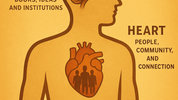As AI promises to free us from drudgery, many feel more overwhelmed than ever. Why is that, and what can we do about it?
Technology promises more efficiency, productivity, and connection than ever before. Yet many of us feel the opposite: overwhelmed, burnt out, and unsure what “meaningful work” even looks like.
The Tension of Progress
AI automates the repetitive. It handles the complex. It even simulates creativity and empathy. In theory, this should free us. But in practice, many of us feel under more pressure than ever — to be constantly available, to learn faster, and to prove our uniquely “human edge.”
This creates a paradox: AI could give us space to be more human, yet the way we use it often makes us feel less so.
The Risk of Forgetting Ourselves
When machines accelerate, we often respond by trying to match their pace. Inboxes checked late at night. Meetings stacked back-to-back. Content consumed in quick scrolls rather than deep reflection.
But we are not machines. We tire. We doubt. We need connection, rest, and meaning. If we neglect this truth, we risk designing a future where humans act like processors — and inevitably break down.
Reclaiming the Human Dimension
Many people are familiar with Maslow’s hierarchy of needs, the pyramid that moves from food and shelter at the base toward self-actualisation at the top. Richard Barrett extended this idea into a more detailed map of human development, called the 7 Levels of Consciousness.
Rather than just describing what individuals need, Barrett’s model shows how our personal values, awareness and priorities evolve over time, and how societies, not just individuals, can grow through these levels.
Here’s a quick guide:
- Survival – meeting basic needs: safety, security, and stability.
- Relationship – building trust, love, and belonging.
- Self-Esteem – developing confidence, recognition, and a sense of contribution.
- Transformation – embracing growth, learning, and adaptability.
- Internal Cohesion – aligning life with values and meaning.
- Making a Difference – applying skills and energy to create positive impact.
- Service – focusing on legacy, global concern, and the wellbeing of future generations.
Right now, much of the global conversation about AI is stuck at Level 1: Survival. The headlines focus on job losses, security threats, and whether humans will be replaced. These are real concerns, but they cannot be the end of the story. If we stay here, fear becomes the driving force behind our choices.
The next step is Level 2: Relationship. If AI can relieve us of survival-driven labour, we have the chance to reinvest in the human qualities that machines cannot replicate — empathy, trust, presence, and genuine connection.
From there, the path continues upward. AI could:
- Support Self-Esteem by helping people showcase their strengths in ways beyond CVs or rigid hierarchies.
- Accelerate Transformation by personalising learning and freeing us to adapt more quickly.
- Strengthen Internal Cohesion by giving us tools to align our work with our values.
- Enable Making a Difference and Service by scaling solutions to global challenges, but only if guided by wisdom, not just efficiency.
In other words, AI is not just a tool. It’s a lever. It can lock us in Survival or liberate us to grow. The direction depends on us, and the questions we are willing to ask about the future we want.
How Does This Work?
These shifts are already visible. Consider:
- Education (Transformation): Instead of overwhelming students with content, AI tutors are personalising learning, adapting to different styles, and freeing teachers to focus on mentoring, relationships, and resilience.
- Newsela: uses AI to tailor reading materials for K–12 students based on level and interest, allowing teachers to spend more time on dialogue and project-based learning.
- Carnegie Mellon University: uses AI tutoring systems that provide individualised feedback, leaving professors free to lead deeper discussions and explorations.
- Healthcare (Relationship): AI diagnostics can scan thousands of results in seconds, but the irreplaceable role of doctors and nurses lies in compassion, trust, and presence.
- Mount Sinai Hospital: uses AI-powered nursing assistants to manage routine tasks, freeing human nurses for direct patient care.
- The University of California San Francisco (UCSF): uses an AI assistant (“Ava”) to track oncology patients’ symptoms and appointments, giving nurses more time for the conversations that build resilience and emotional support.
In both education and healthcare, AI is handling the “survival-level” work, enabling humans to move upward, into relationship, transformation, and beyond.
A Choice of Directions
The wellbeing challenge, then, is not just about reducing burnout. It’s about recognising that the direction of human growth itself is at stake.
AI is a lever. It can accelerate us downward into control and fear, or upward into relationship, growth, and meaning. The difference lies in the questions we ask and the choices we make now.
We will return to those questions in Post 8. For now, it’s worth remembering: the more machines accelerate, the more vital it becomes to ground ourselves in what makes us human, and to consciously choose the next level we want to step into.
Reflective Questions
- What does “meaningful work” look like for you now?
- Where in your life do you feel most deeply connected, and how might that guide your choices at work?
- How might AI be used not to speed you up, but to give you more space for what truly matters?
- If survival is today’s concern, how might you take one small step toward relationship as tomorrow’s focus?
- Which level of the 7 Levels of Consciousness feels most aligned with your life today — and what small step might move you toward the next?
Closing Thought
The age of machines doesn’t demand that we become more like them. It invites us to remember that we are more than we think we are.
The future will not belong to those who move fastest, but to those who nurture presence, empathy, imagination, and above all, relationship. Because relationship is where humanity begins to flourish, and where the next stage of our collective growth must take root.
 unknownx500
unknownx500





